Is Taiwan Doing Enough to Address Climate Change in The Hottest Summer Ever?
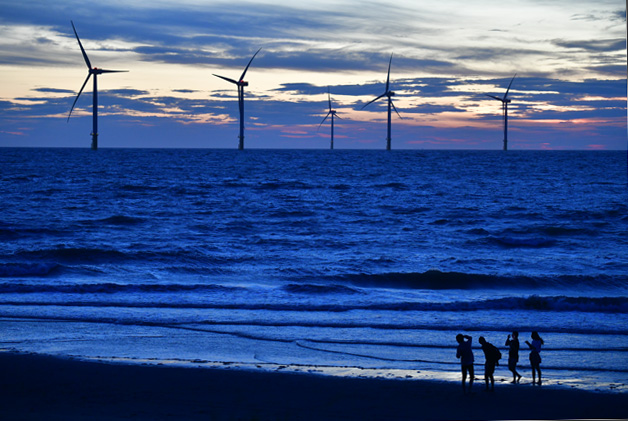
Source:Kuo-Tai Liu
Over the last few months, Taiwan has seen its hottest summer ever due in part to man-made climate change, however Taiwan’s government still does not seem to recognize the scale of the climate issue and Taiwan’s role in it. There does not seem to be enough recognition of the urgency with which Taiwan needs to deal with climate change.
Views
Is Taiwan Doing Enough to Address Climate Change in The Hottest Summer Ever?
By Yi Ling Roy Ngerngweb only
Taiwan passed the Greenhouse Gas Reduction and Management Act in 2015 to reduce greenhouse gas emissions by 50% of 2005 levels by 2050, but Environmental Protection Administration (EPA) Minister Chang Tzi-Chin admitted earlier this year that even to attain the target of reducing emissions by 2% of 2005 levels by 2020 under the act, Taiwan would still have difficulty.
At the launch of the Risk Society and Policy Research Center (RSPRC)’s energy transition report proposal last year, Dr. Lee Hom-Ti, Deputy General Director of the Green Energy and Environment Laboratories (GEL) at the Industrial Technology Research Institute (ITRI) – a government-funded agency – also admitted last year that Taiwan’s current climate strategy would not allow it to achieve its Nationally Determined Contributions (NDCs), or the long-term climate goal of limiting global warming to 1.5°C to 2°C above pre-industrial levels as agreed upon under the Paris Agreement.
Moreover, while increasing electricity price as a form of carbon pricing could be used to curb the use of higher-polluting energy sources, Minister without Portfolio and Minister of National Development Kung Ming-hsin however said at the same launch event that the government would not be increasing electricity price beyond the 3% maximum limit allowable under current regulations, on the claim that the government is not able to dictate price increases.
Taiwan Needs to Confront the Climate Issue and Set Bold Targets to Achieve the Climate Goals
It therefore raises the question of whether Taiwan’s government is in denial of the scale of the problem – Taiwan’s climate goals are simply not enough to sufficiently bring down its emissions to be in line with the Paris Agreement, and to limit global warming to 1.5°C to 2°C above pre-industrial levels.
Moreover, Taiwan’s lack of ambition pales in comparison with other advanced economies. Fundamentally, most other advanced economies have clearly recognized the climate problem and this has spurred bold targets to reduce emissions.
For example, the European Green Deal is upfront that while the European Union (EU) has reduced greenhouse gas emissions by 23% between 1990 and 2018, it also admits that “ current policies will only reduce greenhouse gas emissions by 60% by 2050”, and has therefore aimed for a more ambitious climate goal of achieving climate neutrality by 2050.
Also, while the South Korean Green Deal still lacks a coherent plan, it is noteworthy because of its target to achieve net-zero carbon emissions by 2050.
While the United States (US)’s Green New Deal introduced by Congresswoman Alexandria Ocasio-Cortez last year did not eventually pass, it is also worth studying for its ambitious targets – the US Green New Deal admits to the problem that the US has “historically been responsible for a disproportionate amount of greenhouse gas emissions”, and that it has “emitted 20% of global greenhouse gas emissions through 2014”. It therefore seeks to reduce greenhouse gas emissions to net-zero by 2050.
However, Taiwan’s Greenhouse Gas Reduction and Management Act still only aims to reduce emissions by 50% of 2005 levels by 2050.
In fact, even the mid-term targets set by the US and European green deals are also more ambitious than Taiwan’s. The US’s deal has a target to reduce emissions by 40% to 60% of 2010 levels by 2030, while the European deal has an even more ambitious target to reduce emissions by at least 50% and toward 55% as compared with 1990 levels by 2030.
In Taiwan, the target for 2030 is still only to reduce emissions by 20% as compared with 2005 levels.
However, Taiwan’s current targets are not sufficient to be on par with the United Nations (UN) recommendations, and Greenpeace project director Tang An pointed out that Taiwan might not even reach its goal of cutting emissions by 2% of 2005 levels by this year.
Still, the conversation to acknowledge this inadequacy seems to still be missing at the higher levels in Taiwan’s government.
Taiwan’s Carbon Emissions Are Still Growing Faster than Most Other Advanced Economies
To be fair, Taiwan’s EPA highlighted that while Taiwan’s emissions grew by 110% from 1990 to 2005, emissions grew slower by 0.92% during the subsequent 2005 to 2016 period – which is even lower than Singapore and South Korea.
However, such a comparison might not reflect the urgency of the issue since this is comparing Taiwan with some of the worst carbon emitters – South Korea ranks the 8th most polluting country in the world, while in 2015, Singapore’s per capita emissions were even as high as Taiwan’s. Singapore also ranks 9th most polluting in Asia in terms of emissions per capita. South Korea ranks a higher 4th, while Taiwan ranks 5th, even ahead of Japan (6th) and China (10th). Taiwan’s per capita emissions also ranks 8th in the world among countries with more than a 10 million population.
 Source: Global Carbon Atlas
Source: Global Carbon Atlas
Nonetheless, EPA pointed out that while emissions increased by 0.92% between 2005 and 2016, Taiwan’s gross domestic product (GDP) has instead grown by 42%, which suggests that economic growth has decoupled from that of emissions. However, when you compare Taiwan with the EU, not only has the EU been able to grow its economy, it has been able to do so by reducing emissions – its economy grew by 61% between 1990 and 2018 while emissions dropped by 23%.
Some might say it is not fair to compare Taiwan with other advanced European economies which have had a head start than Taiwan in terms of economic development. While this could be reasonable, even when comparing with the newer East European tech hubs, Taiwan’s performance has been dismal.
From 1960 to 2018, Taiwan increased its total emissions by more than 2,000%, but this compares with an increase of only 7% in the Czech Republic and 10% in Hungary. Moreover, when comparing the Netherlands with Taiwan which has a similar population as Taiwan, its emissions has only increased by 120% from 1960 to 2018, and its emissions today are also less than 60% that of Taiwan’s.
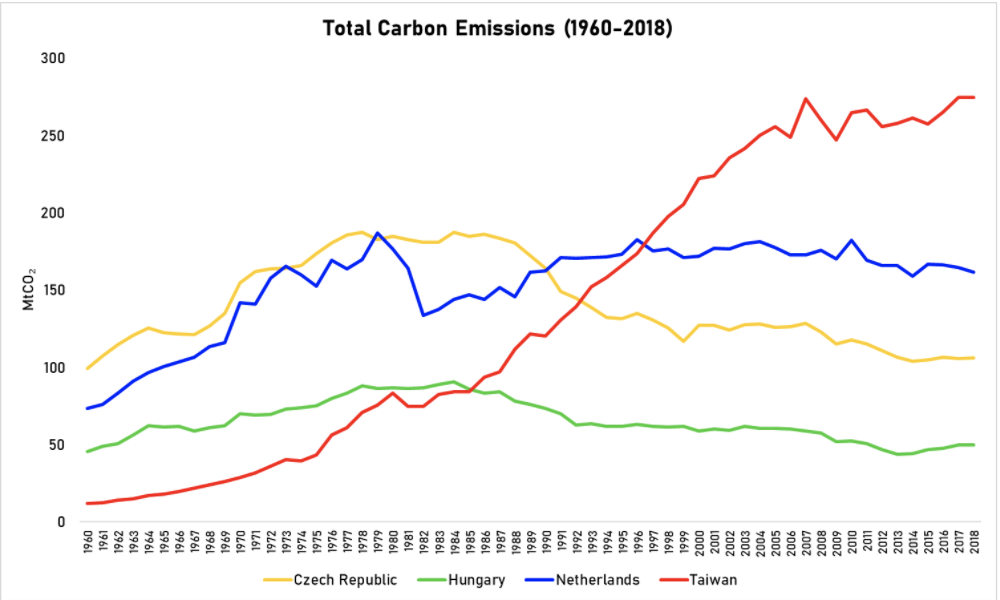 Source: Global Carbon Atlas
Source: Global Carbon Atlas
To give this some perspective, the Netherlands’ GDP grew by 36.5 times between 1960 and 2018 against only a doubling of its emissions growth, but this is compared with a 23-times emissions growth in Taiwan against a GDP growth of 290 times. In other words, the Netherlands’ GDP growth of 18 times its emissions growth is more carbon efficient than Taiwan’s growth of only 13 times. Today, the Netherlands has a GDP that is twice that of Taiwan’s today.
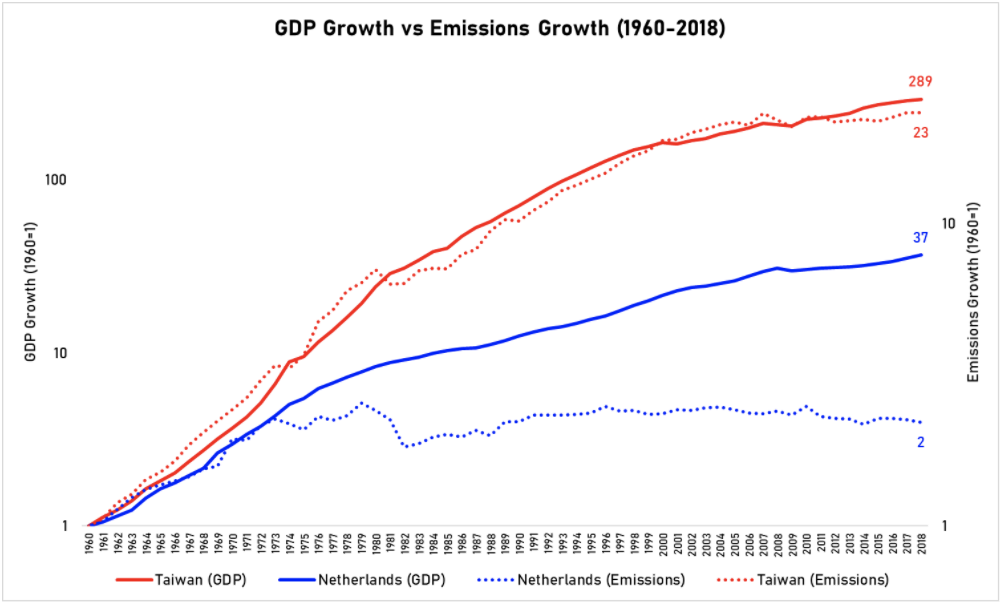 Source: Emissions data: Global Carbon Atlas; GDP data: National Statistics (Taiwan), World Bank (Netherlands)
Source: Emissions data: Global Carbon Atlas; GDP data: National Statistics (Taiwan), World Bank (Netherlands)
In addition, while the total GDP of Taiwan is nearly 2.5 times larger than the Czech Republic and nearly 3.5 times larger than Hungary, but on a per capita basis, Taiwan’s GDP is actually comparable to both these countries. And when you compare their per capita emissions, both the Czech Republic and Hungary have seen their emissions from 1991 to 2018 decline by about 30% and 20% respectively, while growing their GDP per capita by about 700% and 400%. However, Taiwan has instead seen its emissions grow by more than 80% while growing its economy by less than 200%. Even in Romania and Poland, their GDPs per capita grew by 900% and 600% respectively, while their carbon emissions declined by 36% and 9%. Romania started seeing lower emissions than Taiwan since 1991, Hungary since 1992, while Poland, the Netherlands and the Czech Republic also started seeing lower emissions after 1998, 2004 and 2010 respectively.
In other words, Taiwan grew its emissions by the most but grew its economy by the least.
 Source: Emissions data: Global Carbon Atlas; GDP data: National Statistics (Taiwan), World Bank (other countries)
Source: Emissions data: Global Carbon Atlas; GDP data: National Statistics (Taiwan), World Bank (other countries)
In fact, Taiwan says that it wants to reduce emissions by 2% of 2005 levels by this year, but not only has Taiwan not done so, it becomes even more glaring when we compare Taiwan with other advanced economies – it is one of the very few advanced economies which still continue to see growing emissions since 2005. The only other advanced economies which saw growing emissions between 2005 and 2018 were South Korea (43.4%), Singapore (34.7%), Iceland (22.3%), Macao (14.5%), Estonia (14.2%), Israel (13.7%), Australia (7.7%) and Norway (0.9%).
However, 26 other advanced economies were able to grow their economies while reducing their emissions. Moreover, when you compare with other advanced economies with similar populations, Ireland and Czech Republic were both able to grow their economies by nearly as much as Taiwan, while reducing their emissions.
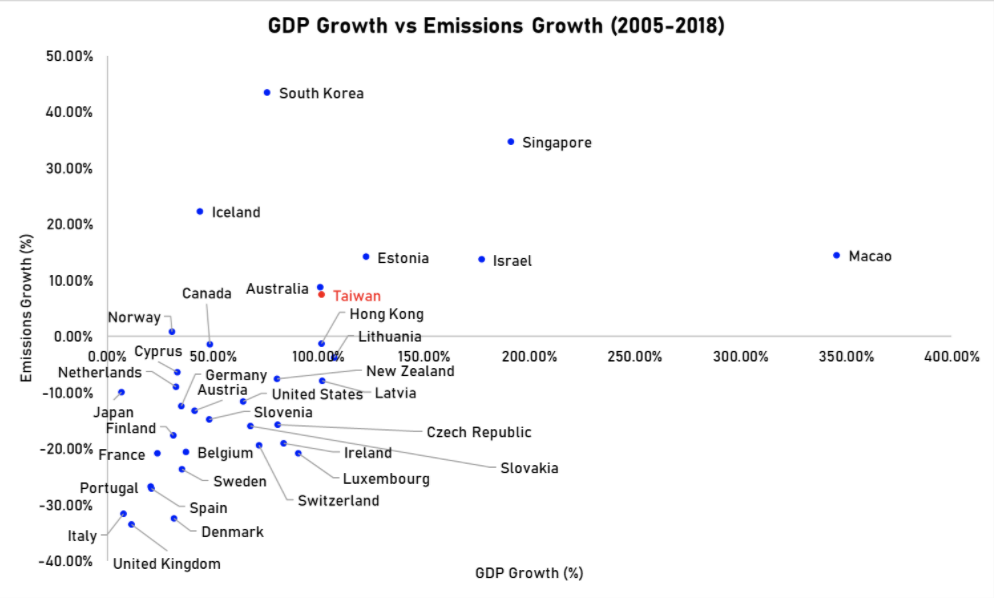 Source: Emissions data: Global Carbon Atlas; GDP data: National Statistics (Taiwan), World Bank (other countries)
Source: Emissions data: Global Carbon Atlas; GDP data: National Statistics (Taiwan), World Bank (other countries)
In fact, on a per capita basis, Taiwan ranks 2nd among the advanced economies with the highest growth in carbon emissions between 1960 and 2018 after South Korea, when accounting for only countries.
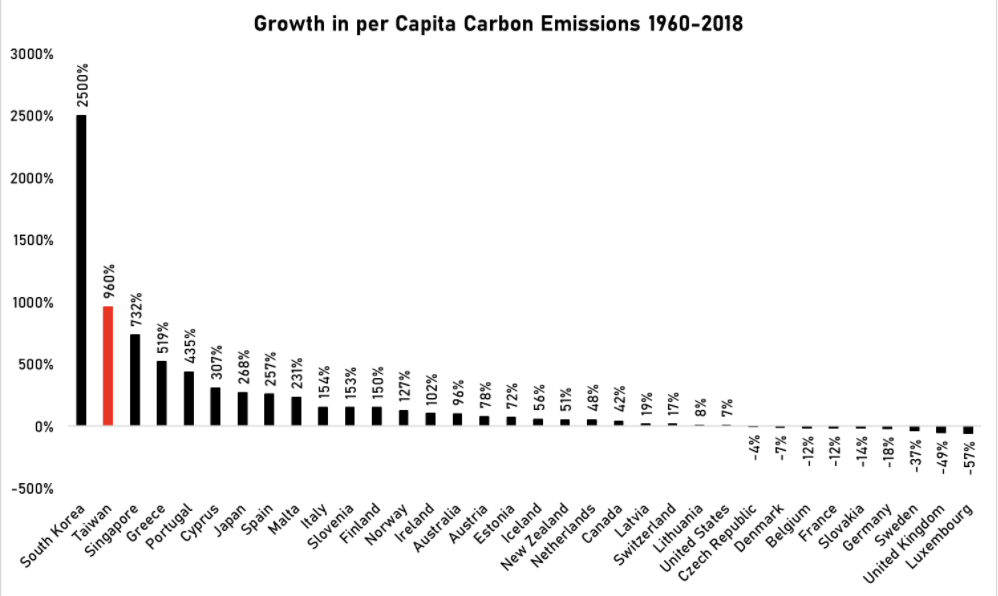 Source: Emissions data: Global Carbon Atlas
Source: Emissions data: Global Carbon Atlas
And even when we take the reference year of 2005 to reduce emissions by 50% as the point for comparison, Taiwan is still the advanced economy with the 6th highest growth in carbon emissions between 2005 and 2018.
 Source: Emissions data: Global Carbon Atlas
Source: Emissions data: Global Carbon Atlas
Taiwan Needs an Immediate Plan to Wean Off Its High-Carbon Economy
The reality therefore is that Taiwan’s economy has been growing on a largely high-carbon pathway which has been carbon inefficient and is in fact polluting – this economic growth model is therefore in dire need of change.
RSPRC director Prof. Chou Kuei-Tien explained that, Taiwan’s over-reliance on its low-cost model and the over-dependence on cheap electricity prices has resulted in a resistance toward transforming away from such a high-carbon structure. But Prof. Chou cautioned that if Taiwan does not undergo transformation, it will lose out as other advanced economies continue to transform toward greener models, so Taiwan therefore needs to reflect on how it wants to transform its business models to continue to be relevant in the age of sustainability.
RSPRC’s postdoctoral researcher Chao Chia-Wei also explained that Taiwan’s carbon emissions have continued to grow because of the increasing electricity consumption. In 2018, not only did Taiwan’s electricity consumption grew by 1.15%, the industrial sector saw an even higher growth of 5.6%. In order to effectively bring down carbon emissions, Dr. Chao pointed out that the international consensus is that carbon pricing would need to be set at US$35 per ton, but this would be difficult to achieve in Taiwan’s context. Nonetheless, Dr. Chao believed that if Taiwan is able to achieve its green energy goals, it would still be possible to achieve the carbon reduction goals set for 2025 and 2030, to reduce carbon emissions by 10% and 20% by 2005 levels.
This however still does not take into account the fact that Taiwan’s current reduction goals are still insufficient to meet the targets under the Paris Agreement.
Moreover, the implementation of the Greenhouse Gas Emission Control Action Programs under Taiwan’s Greenhouse Gas Reduction and Management Act is also fraught with issues – while these programs were supposed to be implemented between 2018 and 2020, the programs were only approved on May 16, 2019 – halfway through the supposed implementation period. Not only that, the Greenhouse Gas Control Implementation Plan was supposed to be implemented from 2018 to 2020, but again the plan was only approved halfway through – on May 16, 2019.
This therefore questions the political will and the seriousness of the government in addressing the climate impact in Taiwan.
In its report to Taiwan’s Executive Yuan on the Greenhouse Gas Reduction and Management Act earlier this year, the EPA continued to use neighboring countries such as China, South Korea and Singapore as a benchmark – however, China is the world’s largest polluter producing almost twice the emissions of the US (which ranks second), so this is setting a very bar for Taiwan. And as mentioned, South Korea is the 8th worst polluter globally.
If Taiwan is serious about transforming itself away from a high-carbon economy to one that runs on low-carbon, then it needs to benchmark itself against the more ambitious targets set in the European Green Deal. It is neither that Taiwan does not have the technological expertise or economic capability to see through a successful energy transition.
What is lacking therefore is a lack of urgency to confront the climate issue at hand, the setting of a very low bar for Taiwan for change, and the conservative targets which the government knows and admits will not enable Taiwan to meet the global targets.
But if so, the question to ask is how serious Taiwan is in its commitment to reducing greenhouse gas emissions.
To be fair, Taiwan’s government has shown commitment in developing its offshore wind industry. The Global Wind Energy Council said that, “Taiwan is by far the most open offshore wind turbines markets in Asia, and has emerged as a great success story of how the right policy framework will create a sustainable and localised industry to benefit the economy while meeting climate goals.” Evwind wrote that, “what the Taiwanese government has done in such a short period of time sets a good example for other Asian countries and global peers alike.” In fact, Taiwan became the 8th largest offshore wind market in the world last year, and only the 2nd largest in Asia, after China.
However, when accounting for renewable energy as a whole, Taiwan’s renewables as a proportion of electricity production is still lower than both Japan and South Korea, and aside from other advanced economies Israel, Singapore, Puerto Rico, Hong Kong and Macao, Taiwan actually has the lowest renewables mix among the advanced economies.
 Source: Ember
Source: Ember
Truth is, Taiwan sits with the other Asian Tigers as not doing enough to mitigate climate change, but while both South Korea and Japan have pledged to become carbon neutral by 2050 (the latter just after 2050), and even Singapore has said it aims to achieve net zero emissions “as soon as viable” in the second half of the century, Taiwan has not made a similar pledge to do so.
Taiwan has an opportunity to become a global player and climate leader in Asia, and while Taiwan has made significant inroads in establishing itself as an important hub in Asia for offshore wind, but in order to set itself apart from its neighbors and become future-relevant, Taiwan needs to set more ambitious targets to reduce emissions and develop a clear plan to use its technological capabilities to help it achieve these climate targets by 2050.
Have you read?
♦ Taiwan’s Solar Power Dream Collides with Reality
♦ The ‘Ghost’ Shadowing Taiwan’s Industrial Polluters
♦ How Can Solar Power Arrays Co-exist with Nature?
Uploaded by Penny Chiang






